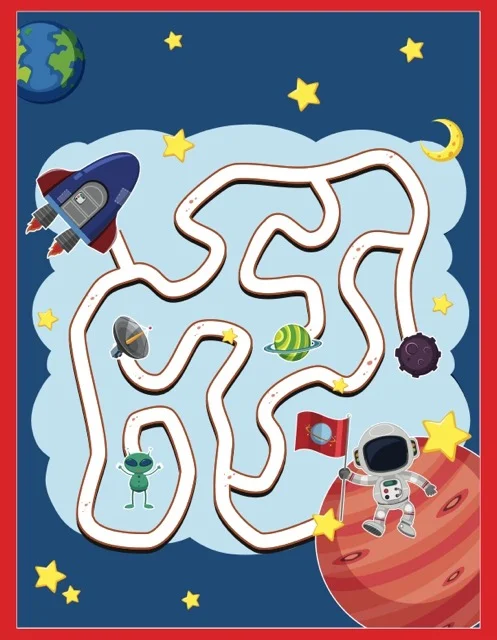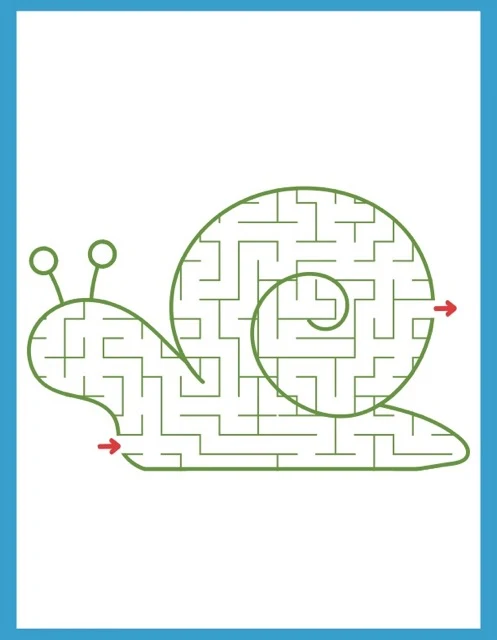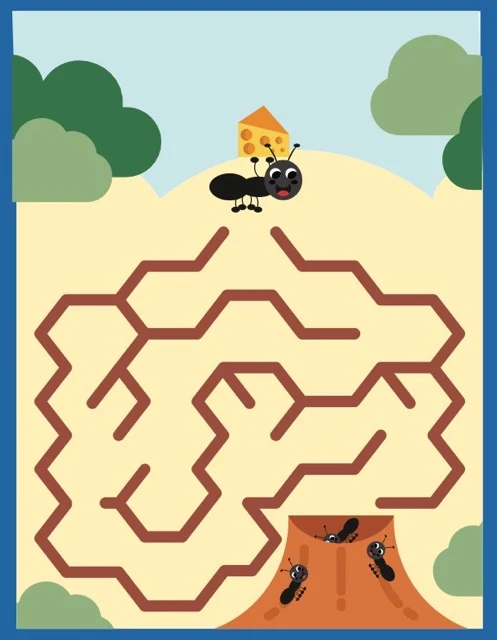50 Mazes: A Children's Activity Book
"50 Mazes" is a children's book containing fifty diverse mazes designed to enhance cognitive skills. The mazes vary in type (classic, number, alphabet, themed) and difficulty, catering to a wide age range. Colorful illustrations and engaging themes, such as animals, make the puzzles visually appealing. The book offers benefits including improved problem-solving, spatial reasoning, concentration, and hand-eye coordination, making it suitable for both personal use and educational settings. The recommendation is to purchase individual copies, although copyright information should be checked regarding photocopying.
50 Mazes: A Collection of Engaging Puzzles
Briefing Document: "50 Mazes"
Overview:
"50 Mazes" is a book designed to provide entertainment and cognitive benefits for children of all ages. It features a diverse collection of 50 unique mazes with varying themes and difficulty levels. The book aims to develop problem-solving skills, improve hand-eye coordination, and promote concentration through enjoyable puzzle solving.
Key Features:
●
Maze Types:
○
Classic Mazes: Traditional mazes where the goal is to find a path from start to finish.
○
Number Mazes: Mazes solved by following a numerical sequence.
○
Alphabet Mazes: Mazes navigated by tracing letters of the alphabet in order.
○
Themed Mazes: Mazes based on specific themes like animals, underwater worlds, and outer space.
●
Difficulty Levels: The book caters to a range of skill levels by including mazes of varying complexity, making it suitable for beginners and experienced solvers.
●
Visual Appeal: The mazes are characterized by their colorful and engaging illustrations, enhancing the overall experience. As seen in the excerpts, a common theme is animals, incorporated into the designs.
●
Cognitive Benefits: Solving mazes offers several cognitive benefits, including:
○
Improved problem-solving skills: "Mazes require logical thinking and strategic planning to find the solution."
○
Enhanced spatial reasoning: "Navigating through mazes helps develop spatial awareness and understanding of directions."
○
Increased concentration: "Solving mazes requires focus and attention to detail."
○
Boosted hand-eye coordination: "Tracing the path through the maze improves hand-eye coordination and fine motor skills."
Educational Applications:
Beyond personal enjoyment, "50 Mazes" can be used as an educational resource to supplement lessons on spatial reasoning, problem-solving, and fine motor skills. Teachers and educators can incorporate the mazes into their curriculum to engage students in a fun and interactive learning experience.
Target Audience:
The book is designed for a wide range of ages, from preschoolers to older children, and even adults who enjoy brain teasers. The variety of maze types and difficulty levels ensures something for everyone.
Recommendations:
It is generally recommended to purchase individual copies of "50 Mazes" for each child to ensure the best experience. However, consulting the book's copyright information for specific guidelines on photocopying is advised.
Conclusion:
"50 Mazes" offers a comprehensive collection of engaging and visually appealing mazes that can provide hours of entertainment and cognitive stimulation for children of all ages. Its diverse range of maze types, difficulty levels, and themes makes it an excellent resource for personal enjoyment and educational purposes.
50 Mazes: A Collection of Brain-Boosting Puzzles
FAQ: 50 Mazes
1. What is the purpose of this book?
This book is designed to provide hours of entertainment and brain-boosting fun for children of all ages. With 50 unique mazes featuring a variety of themes and difficulty levels, it is the perfect activity for developing problem-solving skills, improving hand-eye coordination, and promoting concentration.
2. What types of mazes are included in the book?
The book features a diverse collection of mazes, including:
●
Classic mazes: These traditional mazes challenge you to find the path from the starting point to the end.
●
Number mazes: Follow the sequence of numbers to solve these mazes.
●
Alphabet mazes: Trace the letters of the alphabet in order to navigate the maze.
●
Themed mazes: Embark on exciting adventures with mazes based on themes such as animals, underwater worlds, and outer space.
3. What are the difficulty levels of the mazes?
The mazes in the book are designed to cater to a wide range of ages and abilities. Some mazes are simple and perfect for beginners, while others are more complex and challenging, suitable for experienced maze solvers.
4. What are the benefits of solving mazes?
Solving mazes offers numerous cognitive benefits, including:
●
Improved problem-solving skills: Mazes require logical thinking and strategic planning to find the solution.
●
Enhanced spatial reasoning: Navigating through mazes helps develop spatial awareness and understanding of directions.
●
Increased concentration: Solving mazes requires focus and attention to detail.
●
Boosted hand-eye coordination: Tracing the path through the maze improves hand-eye coordination and fine motor skills.
5. Is this book suitable for a specific age group?
The book is suitable for a wide range of ages, from preschoolers to older children and even adults who enjoy a good brain teaser. The variety of maze types and difficulty levels ensures there is something for everyone.
6. Can I use this book in an educational setting?
Absolutely! This book is an excellent resource for teachers and educators. It can be used to supplement lessons on spatial reasoning, problem-solving, and fine motor skills.
7. Can I photocopy the mazes for multiple children to use?
It is generally recommended to purchase individual copies of the book for each child to ensure the best experience. However, you may want to consult the copyright information within the book for specific guidelines on photocopying.
8. What makes this book stand out from other maze books?
"50 Mazes" offers a comprehensive collection of engaging and visually appealing mazes that will keep children entertained for hours. Its wide variety of maze types, difficulty levels, and themes ensures there's a challenge for everyone.
50 Mazes Study Guide
"50 Mazes" Study Guide
Quiz
1.
What is the primary purpose of "50 Mazes"?
2.
Describe two distinct types of mazes included in the book.
3.
How does "50 Mazes" cater to a range of skill levels?
4.
Identify three cognitive benefits of solving mazes.
5.
Beyond personal enjoyment, what is another potential use for "50 Mazes"?
6.
What is the general recommendation regarding photocopying the mazes?
7.
What characteristic of the mazes in the book ensures visual appeal?
8.
Based on the provided excerpts, what is a common theme featured in the mazes?
9.
How are numbers incorporated into some of the mazes?
10.
What is the primary goal in a classic maze?
Answer Key
1.
The primary purpose of "50 Mazes" is to provide entertainment and brain-boosting fun for children of all ages.
2.
Two distinct types of mazes in the book are classic mazes, where the goal is to find a path from start to finish, and alphabet mazes, which involve tracing letters in order to navigate.
3.
"50 Mazes" caters to a range of skill levels by including mazes of varying complexity. Simpler mazes are suitable for beginners, while more intricate designs challenge experienced solvers.
4.
Three cognitive benefits of solving mazes are improved problem-solving skills, enhanced spatial reasoning, and increased concentration.
5.
Beyond personal enjoyment, "50 Mazes" can be used as an educational resource to supplement lessons on spatial reasoning, problem-solving, and fine motor skills.
6.
The general recommendation is to purchase individual copies of "50 Mazes" for each child to ensure the best experience.
7.
The mazes in the book are visually appealing due to their colorful and engaging illustrations.
8.
A common theme featured in the mazes is animals, with various creatures incorporated into the designs.
9.
Numbers are incorporated into some mazes by creating paths that must be followed in numerical order.
10.
The primary goal in a classic maze is to find a path from the starting point to the designated endpoint.
Essay Questions
1.
Analyze the design and layout of a specific maze from "50 Mazes," discussing its visual elements, potential difficulty level, and target audience.
2.
Discuss the role of mazes in fostering cognitive development in children.
3.
Compare and contrast different types of mazes featured in "50 Mazes," exploring their unique challenges and benefits.
4.
Evaluate the suitability of "50 Mazes" as an educational resource for classroom settings.
5.
Design your own maze, specifying its type, theme, difficulty level, and target audience.
Glossary of Key Terms
Classic Maze: A traditional maze where the objective is to find a path from the entrance to the exit.
Number Maze: A maze that incorporates numbers into the design, often requiring the solver to follow a numerical sequence.
Alphabet Maze: A maze where the path is formed by tracing letters of the alphabet in order.
Themed Maze: A maze that incorporates a specific theme or topic into its design, such as animals, underwater worlds, or outer space.
Problem-solving Skills: The ability to identify problems, analyze information, and develop effective solutions.
Spatial Reasoning: The ability to understand and manipulate objects and relationships in space.
Concentration: The ability to focus attention on a specific task or stimulus.
Hand-eye Coordination: The ability to coordinate the movements of the hands and eyes.
Fine Motor Skills: The ability to make precise movements using the small muscles of the hands and fingers.

















































